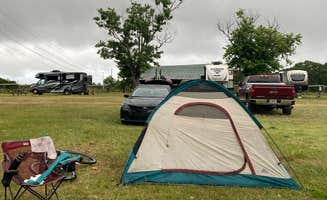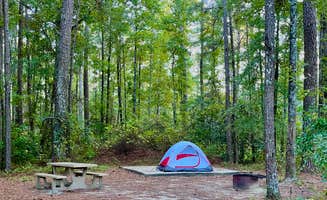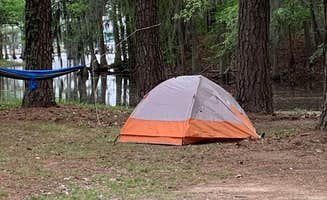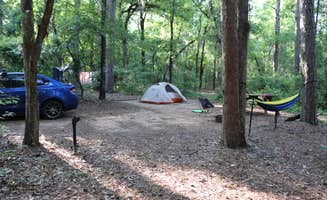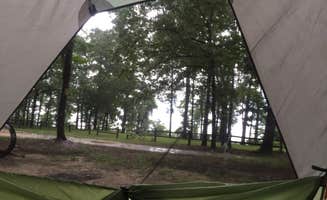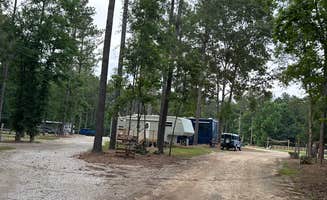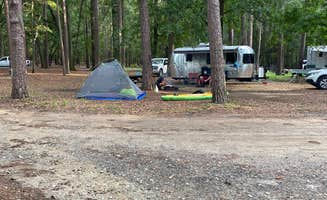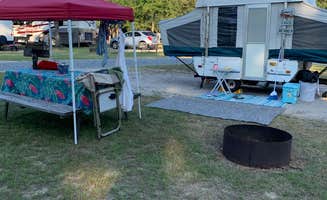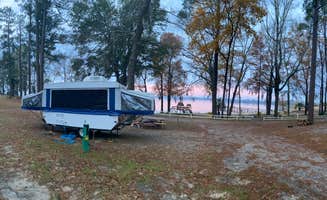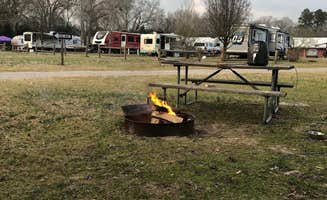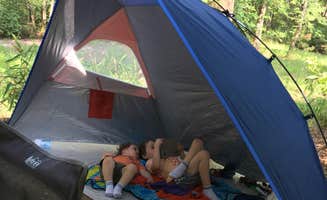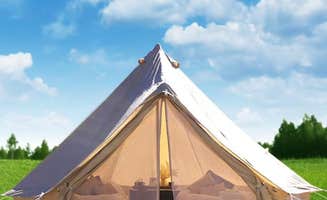Camping sites near St. Matthews, South Carolina offer varied terrain spanning from pine forests to lakefront settings within a 30-mile radius. The region experiences hot, humid summers with temperatures regularly exceeding 90°F from June through August, while spring and fall provide milder conditions favorable for tent camping. Many campsites throughout the area maintain open status year-round, though seasonal flooding can impact accessibility, particularly in low-lying areas.
What to do
Hiking trails at Poinsett State Park: Multiple trails suitable for various skill levels with unique terrain features. At Poinsett State Park Campground, visitors find opportunities for both hiking and mountain biking. "The hiking trails are very nice. The camp sites were on the smaller side but opened up to a large field area where the kids and dog could run around and play," noted one camper. The park's location in the sandhills creates distinctive trail conditions compared to other regional parks.
Fishing opportunities: Several waterfront camping locations offer bank fishing access without requiring boat launch. "We had an awesome view from our campsite of Santee Lake," reported one visitor at Palmetto Shores RV Resort. Fishing from the shoreline proves especially productive during early morning or evening hours when temperatures are cooler.
Swimming access: Multiple lakefront camping areas feature designated swimming zones, though availability varies by season. "The lake access had a beach area that the kids (3 and 1) loved to play at and there was no rocks around that area or dangerous drop offs," mentioned one camper about The Lakeshore Campground. Swimming areas typically operate from April through September, weather permitting.
What campers like
Lakefront views: Sites situated along Lake Marion provide direct water access and scenic views. At The Lakeshore Campground, campers appreciate the spacious waterfront locations. "Spacious, well wooded and there was a fantastic breeze all weekend with helped with the heat and bugs!" one reviewer stated. Waterfront sites typically fill quickly during peak season, particularly those offering flat terrain and shade.
Spacious, level sites: Several campgrounds in the area feature well-designed camping pads with adequate spacing. "Our full hook-up site was almost perfectly level with a fire ring and picnic table. We stayed in a back-in site, which we were grateful for since they are all in the shade," reported a visitor at Outside Inn Campground. Sites at this facility include amenities designed for longer stays.
Wildlife observation: Multiple locations offer opportunities to view wildlife in natural settings. "We saw other wildlife around the campground too. A lizard during a walk during the day. Many frogs during the rain at night," noted a visitor at Longleaf Campground. Wildlife viewing proves most productive during early morning hours or around dusk.
What you should know
Weather impacts: Heavy rain can significantly affect camping conditions, particularly at lower elevation sites. "The first night got a lot of rain and storms and several of the campers from sites farther back left saying they were flooded out. Our site did have some water during the storm but it was gone by morning," reported one camper at Longleaf Campground. Sites situated on higher ground typically drain better after rainfall events.
Campground access considerations: Road conditions vary significantly among camping areas. "The park road is very narrow and uneven with lots of large pot holes. The road to the campground is a little better, but also very narrow," explained one visitor about Poinsett State Park. Larger RVs and trailers may encounter challenges on narrower access roads.
Bathhouse conditions: Facility maintenance levels vary considerably between campgrounds. "The vault toilet was disgusting, covered in splattered poop and very smelly. I sometimes drove to the visitor center to use the flush toilet and sink there," noted a camper at Longleaf Campground. More developed campgrounds typically offer better bathroom facilities than primitive areas.
Tips for camping with families
Playground access: Several campgrounds feature dedicated play areas for children. At Santee Lakes KOA, "Great playground along the shore" was highlighted by one visitor. These amenities provide convenient recreation options directly within camping areas.
Bug prevention: Insect protection is essential, particularly during warmer months. "Definitely bring a wagon for packing your stuff in and prepare to be eaten alive by deer flies everywhere you go! The heat in June is also pretty bad," warned one camper about Longleaf Campground. Bug spray with DEET provides the most effective protection against biting insects.
Swimming conditions: Beach areas offer water access but have varying conditions. "The lake access had a beach area that the kids loved to play at and there was no rocks around that area or dangerous drop offs," noted a visitor about The Lakeshore Campground. Swimming areas at more developed campgrounds typically receive more regular maintenance.
Tips from RVers
Site selection for large rigs: Choose locations carefully if traveling with larger vehicles. "Long RVs and trailers may have trouble with the trees and turns of the campground," advised one RVer about Poinsett State Park. Many established campgrounds provide site dimensions online to assist with planning.
Utilities and hookups: Water quality and electrical service reliability vary across campgrounds. "Hookups are convenient, and work well," reported a visitor at Santee Lakes KOA. Full-hookup sites typically command higher fees but offer greater convenience for extended stays.
Level sites: Ground conditions impact setup time and comfort. "Sites were tight for a rig that big but we made it work. Our site was level, others were definitely not," noted one RVer at Santee Lakes KOA. Bringing leveling blocks or stabilizers proves helpful at many area campgrounds.


